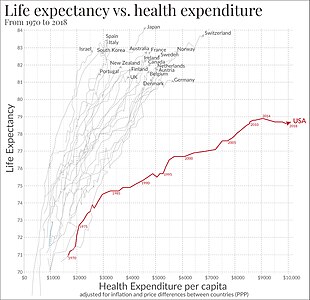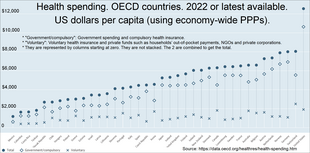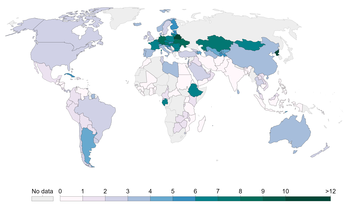Health care

Health care,orhealthcare,is the improvement ofhealthvia theprevention,diagnosis,treatment,ameliorationorcureofdisease,illness,injury,and otherphysical and mental impairmentsin people. Health care is delivered byhealth professionalsandallied health fields.Medicine,dentistry,pharmacy,midwifery,nursing,optometry,audiology,psychology,occupational therapy,physical therapy,athletic training,and otherhealth professionsall constitute health care. The term includes work done in providingprimary care,secondary care,tertiary care,andpublic health.
Access to healthcare may vary across countries, communities, and individuals, influenced by social and economic conditions andhealth policies.Providing health care services means "the timely use of personal health services to achieve the best possible health outcomes".[3]Factors to consider in terms of healthcare access include financial limitations (such as insurance coverage),geographicalandlogisticalbarriers (such as additional transportation costs and the ability to take paid time off work to use such services),socioculturalexpectations, and personal limitations (lack of ability to communicate with health care providers, poorhealth literacy,low income).[4]Limitations to health care services affect negatively the use of medical services, the efficacy of treatments, and overall outcome (well-being, mortality rates).
Health systemsare theorganizationsestablished to meet the health needs of targeted populations. According to theWorld Health Organization(WHO), a well-functioning healthcare system requires a financing mechanism, a well-trained and adequately paidworkforce,reliable information on which to base decisions andpolicies,and well-maintainedhealth facilitiesto deliver quality medicines and technologies.
An efficient healthcare system can contribute to a significant part of a country'seconomy,development, andindustrialization.Health care is an important determinant in promoting the generalphysicalandmental healthandwell-beingof people around the world.[5]An example of this was the worldwideeradicationofsmallpoxin 1980, declared by the WHO, as the firstdiseasein human history to be eliminated by deliberate healthcare interventions.[6]
Delivery
[edit]
The delivery of modern health care depends on groups of trainedprofessionalsandparaprofessionalscoming together asinterdisciplinary teams.[7]This includes professionals inmedicine,psychology,physiotherapy,nursing,dentistry,midwiferyandallied health,along with many others such aspublic health practitioners,community health workersandassistive personnel,who systematically provide personal and population-based preventive, curative andrehabilitativecare services.[citation needed]
While the definitions of the various types of health care vary depending on the differentcultural,political, organizational, and disciplinary perspectives, there appears to be some consensus that primary care constitutes the first element of a continuing health care process and may also include the provision of secondary and tertiary levels of care.[8]Health care can be defined as eitherpublicorprivate.[citation needed]

Primary care
[edit]
Primary carerefers to the work ofhealth professionalswho act as a first point of consultation for allpatientswithin thehealth care system.The primary care model supports first-contact, accessible, continuous, comprehensive and coordinated person-focused care.[10]Such a professional would usually be aprimary care physician,such as ageneral practitionerorfamily physician.Another professional would be a licensed independent practitioner such as aphysiotherapist,or a non-physician primary care provider such as aphysician assistantornurse practitioner.Depending on the locality and health system organization, the patient may see another health care professional first, such as apharmacistornurse.Depending on the nature of the health condition,patientsmay bereferredfor secondary or tertiary care.[citation needed]
Primary care is often used as the term for the health care services that play a role in the local community. It can be provided in different settings, such asUrgent carecenters that provide same-day appointments or services on a walk-in basis.[citation needed]
Primary care involves the widest scope of health care, including all ages of patients, patients of allsocioeconomicand geographic origins, patients seeking to maintain optimalhealth,and patients with all types of acute and chronic physical,mentaland social health issues, includingmultiple chronic diseases.Consequently, a primary care practitioner must possess a wide breadth of knowledge in many areas.Continuityis a key characteristic of primary care, as patients usually prefer to consult the same practitioner for routine check-ups andpreventive care,health education,and every time they require an initial consultation about a new health problem. TheInternational Classification of Primary Care(ICPC) is a standardized tool for understanding and analyzing information on interventions in primary care based on the reason for the patient's visit.[11]
Common chronic illnesses usually treated in primary care may include, for example,hypertension,diabetes,asthma,COPD,depressionandanxiety,back pain,arthritisorthyroid dysfunction.Primary care also includes many basicmaternaland child health care services, such asfamily planningservices andvaccinations.In the United States, the 2013National Health Interview Surveyfound that skin disorders (42.7%), osteoarthritis and joint disorders (33.6%), back problems (23.9%), disorders of lipid metabolism (22.4%), and upper respiratory tract disease (22.1%, excluding asthma) were the most common reasons for accessing a physician.[12]
In the United States, primary care physicians have begun to deliver primary care outside of the managed care (insurance-billing) system throughdirect primary carewhich is a subset of the more familiarconcierge medicine.Physicians in this model bill patients directly for services, either on a pre-paid monthly, quarterly, or annual basis, or bill for each service in the office. Examples of direct primary care practices includeFoundation Healthin Colorado andQliancein Washington.[citation needed]
In the context of globalpopulation aging,with increasing numbers of older adults at greater risk of chronicnon-communicable diseases,rapidly increasing demand for primary care services is expected in both developed and developing countries.[13][14]TheWorld Health Organizationattributes the provision of essential primary care as an integral component of an inclusiveprimary health carestrategy.[8]
Secondary care
[edit]
Secondary careincludesacute care:necessary treatment for a short period of time for a brief but serious illness, injury, or other health condition. This care is often found in ahospitalemergency department.Secondary care also includes skilled attendance duringchildbirth,intensive care,andmedical imagingservices.[16]
The term "secondary care" is sometimes used synonymously with "hospital care". However, many secondary care providers, such aspsychiatrists,clinical psychologists,occupational therapists,mostdental specialtiesorphysiotherapists,do not necessarily work in hospitals. Some primary care services are delivered within hospitals. Depending on the organization and policies of the national health system, patients may be required to see a primary care provider for areferralbefore they can access secondary care.[17][18]
In countries that operate under amixed markethealth care system, somephysicianslimit their practice to secondary care by requiring patients to see a primary care provider first. This restriction may be imposed under the terms of the payment agreements in private or grouphealth insuranceplans. In other cases,medical specialistsmay see patients without a referral, and patients may decide whether self-referral is preferred.[citation needed]
In other countries patient self-referral to amedical specialistfor secondary care is rare as prior referral from another physician (either a primary care physician or another specialist) is considered necessary, regardless of whether the funding is fromprivate insurance schemesornational health insurance.[citation needed]
Allied health professionals,such asphysical therapists,respiratory therapists,occupational therapists,speech therapists,anddietitians,also generally work in secondary care, accessed through either patient self-referral or through physician referral.[citation needed]
Tertiary care
[edit]
Tertiary careis specialized consultative health care, usually forinpatientsand on referral from a primary or secondary health professional, in a facility that has personnel and facilities for advancedmedicalinvestigation and treatment, such as atertiary referral hospital.[19]
Examples of tertiary care services arecancermanagement,neurosurgery,cardiac surgery,plastic surgery,treatment for severeburns,advancedneonatologyservices, palliative, and other complex medical and surgical interventions.[20]
Quaternary care
[edit]The termquaternary careis sometimes used as an extension of tertiary care in reference to advanced levels of medicine which are highlyspecializedand not widely accessed.Experimental medicineand some types of uncommondiagnosticorsurgicalprocedures are considered quaternary care. These services are usually only offered in a limited number of regional or national health care centers.[20][21]
Home and community care
[edit]Many types of health care interventions are delivered outside of health facilities. They include many interventions ofpublic healthinterest, such asfood safetysurveillance, distribution ofcondomsandneedle-exchange programsfor the prevention of transmissible diseases.[citation needed]
They also include the services of professionals in residential and community settings in support ofself-care,home care,long-term care,assisted living,treatment forsubstance use disordersamong other types of health and social care services.[citation needed]
Communityrehabilitationservices can assist with mobility and independence after the loss of limbs or loss of function. This can includeprostheses,orthotics,orwheelchairs.[citation needed]
Many countries are dealing with aging populations, so one of the priorities of the health care system is to help seniors live full, independent lives in the comfort of their own homes. There is an entire section of health care geared to providing seniors with help in day-to-day activities at home such as transportation to and from doctor's appointments along with many other activities that are essential for their health and well-being. Although they provide home care for older adults in cooperation, family members and care workers may harbor diverging attitudes and values towards their joint efforts. This state of affairs presents a challenge for the design of ICT (information and communication technology) for home care.[22]
Because statistics show that over 80 million Americans have taken time off of their primary employment to care for a loved one,[23]many countries have begun offering programs such as the Consumer Directed Personal Assistant Program to allow family members to take care of their loved ones without giving up their entire income.[citation needed]
With obesity in children rapidly becoming a major concern, health services often set up programs in schools aimed at educating children about nutritional eating habits, making physical education a requirement and teaching young adolescents to have a positive self-image.[24]
Ratings
[edit]Health care ratingsare ratings orevaluationsof health care used to evaluate the process of care and health care structures and/or outcomes of health care services. This information is translated into report cards that are generated by quality organizations, nonprofit, consumer groups and media. This evaluation of quality is based on measures of:[citation needed]
- health planquality
- hospital quality
- ofpatient experience
- physician quality
- quality for other health professionals
Access to health care
[edit]Access to healthcare may vary across countries, communities, and individuals, influenced by social and economic conditions as well ashealth policies.Providing health care services means "the timely use of personal health services to achieve the best possible health outcomes".[3]Factors to consider in terms of healthcare access include financial limitations (such as insurance coverage),geographicalandlogisticalbarriers (such as additional transportation costs and the ability to take paid time off work to use such services),socioculturalexpectations, and personal limitations (lack of ability to communicate with health care providers, poorhealth literacy,low income).[4]Limitations to health care services affects negatively the use of medical services, the efficacy of treatments, and overall outcome (well-being, mortality rates).[citation needed]
Related sectors
[edit]Health care extends beyond the delivery of services to patients, encompassing many related sectors, and is set within a bigger picture of financing and governance structures.
Health system
[edit]Ahealth system,also sometimes referred to ashealth care systemorhealthcare system,is the organization of people, institutions, and resources that deliver health care services to populations in need.[citation needed]
Industry
[edit]Thehealthcare industryincorporates several sectors that are dedicated to providing health care services and products. As a basic framework for defining the sector, the United Nations'International Standard Industrial Classificationcategorizes health care as generally consisting of hospital activities, medical and dental practice activities, and "other human health activities." The last class involves activities of, or under the supervision of, nurses, midwives, physiotherapists, scientific or diagnostic laboratories, pathology clinics, residential health facilities, patient advocates[25]or otherallied health professions.
In addition, according to industry and market classifications, such as theGlobal Industry Classification Standardand theIndustry Classification Benchmark,health care includes many categories of medical equipment, instruments and services includingbiotechnology,diagnostic laboratories and substances, drug manufacturing and delivery.[citation needed]
For example, pharmaceuticals and other medical devices are the leading high technology exports of Europe and the United States.[26][27]The United States dominates thebiopharmaceuticalfield, accounting for three-quarters of the world's biotechnology revenues.[26][28]
Research
[edit]The quantity and quality of many health care interventions are improved through the results of science, such as advanced through themedical modelof health which focuses on the eradication ofillnessthroughdiagnosisand effective treatment. Many important advances have been made through health research,biomedical researchandpharmaceutical research,which form the basis forevidence-based medicineandevidence-based practicein health care delivery. Health care research frequently engages directly with patients, and as such issues for whom to engage and how to engage with them become important to consider when seeking to actively include them in studies. While single best practice does not exist, the results of a systematic review on patient engagement suggest that research methods for patient selection need to account for both patient availability and willingness to engage.[29]
Health services researchcan lead to greater efficiency and equitable delivery of health care interventions, as advanced through thesocial model of health and disability,which emphasizes the societal changes that can be made to make populations healthier.[30]Results from health services research often form the basis ofevidence-based policyin health care systems.Health services researchis also aided by initiatives in the field of artificial intelligence for the development of systems of health assessment that are clinically useful, timely, sensitive to change,culturally sensitive,low-burden, low-cost, built into standard procedures, and involve the patient.[31]
Financing
[edit]Graphs are unavailable due to technical issues. There is more info onPhabricatorand onMediaWiki.org. |
There are generally five primary methods of fundinghealth care systems:[33]
- Generaltaxationto the state, county or municipality
- Social health insurance
- Voluntary or privatehealth insurance
- Out-of-pocket payments
- Donationsto healthcharities

In most countries, there is a mix of all five models, but this varies across countries and over time within countries. Aside from financing mechanisms, an important question should always be how much to spend on health care. For the purposes of comparison, this is often expressed as the percentage of GDP spent on health care. InOECDcountries for every extra $1000 spent on health care, life expectancy falls by 0.4 years.[35]A similar correlation is seen from the analysis carried out each year by Bloomberg.[36]Clearly this kind of analysis is flawed in that life expectancy is only one measure of a health system's performance, but equally, the notion that more funding is better is not supported.[citation needed]
In 2011, thehealth care industryconsumed an average of 9.3 percent of theGDPorUS$3,322 (PPP-adjusted) per capita across the 34 members ofOECDcountries. The US (17.7%, or US$ PPP 8,508), theNetherlands(11.9%, 5,099),France(11.6%, 4,118),Germany(11.3%, 4,495),Canada(11.2%, 5669), andSwitzerland(11%, 5,634) were the top spenders, howeverlife expectancy in total population at birthwas highest in Switzerland (82.8 years),JapanandItaly(82.7),SpainandIceland(82.4), France (82.2) andAustralia(82.0), while OECD's average exceeds 80 years for the first time ever in 2011: 80.1 years, a gain of 10 years since 1970. The US (78.7 years) ranges only on place 26 among the 34 OECD member countries, but has the highest costs by far. All OECD countries have achieved universal (or almost universal) health coverage, except the US andMexico.[37][38](see alsointernational comparisons.)
In theUnited States,where around 18% of GDP is spent on health care,[36]theCommonwealth Fundanalysis of spend and quality shows a clear correlation between worse quality and higher spending.[39]
Expand theOECDcharts below to see the breakdown:
- "Government/compulsory": Government spending and compulsory health insurance.
- "Voluntary": Voluntary health insurance and private funds such as households' out-of-pocket payments, NGOs and private corporations.
- They are represented by columns starting at zero. They are not stacked. The 2 are combined to get the total.
- At the source you can run your cursor over the columns to get the year and the total for that country.[40]
- Click the table tab at the source to get 3 lists (one after another) of amounts by country: "Total", "Government/compulsory", and "Voluntary".[40]


Administration and regulation
[edit]Themanagement and administration of health careis vital to the delivery of health care services. In particular, the practice of health professionals and the operation of health care institutions is typicallyregulatedby national or state/provincial authorities through appropriate regulatory bodies for purposes ofquality assurance.[41]Most countries have credentialing staff in regulatory boards orhealth departmentswho document thecertification or licensing of health workersand their work history.[42]
Health information technology
[edit]Health information technology (HIT) is "the application of information processing involving both computer hardware and software that deals with the storage, retrieval, sharing, and use of health care information, data, and knowledge for communication and decision making."[43]
Health information technology components:
- Electronic health record(EHR) – An EHR contains a patient's comprehensive medical history, and may include records from multiple providers.[44]
- Electronic Medical Record(EMR) – An EMR contains the standard medical and clinical data gathered in one's provider's office.[44]
- Health information exchange(HIE) – Health Information Exchange allows health care professionals and patients to appropriately access and securely share a patient's vital medical information electronically.[45]
- Medical practice management software(MPM) – is designed to streamline the day-to-day tasks of operating a medical facility. Also known as practice management software or practice management system (PMS).[citation needed]
- Personal health record(PHR) – A PHR is a patient's medical history that is maintained privately, for personal use.[46]
See also
[edit]- Category:Health care by country
- Global health
- Health equity
- Health policy
- Healthcare system/Health professionals
- Tobacco control laws
- Universal health care
References
[edit]- ^"Hospital beds per 1,000 people".Our World in Data.Archivedfrom the original on 12 April 2020.Retrieved7 March2020.
- ^"Governor Hochul, Mayor Adams Announce Plan for SPARC Kips Bay, First-of-Its-Kind Job and Education Hub for Health and Life Sciences Innovation".State of New York.13 October 2022.Archivedfrom the original on 1 November 2022.Retrieved13 October2022.
- ^abInstitute of Medicine (US) Committee on Monitoring Access to Personal Health Care Services, Millman M (1993).Access to Health Care in America.The National Academies Press, US National Academies of Science, Engineering and Medicine.doi:10.17226/2009.ISBN978-0-309-04742-5.PMID25144064.Archivedfrom the original on 11 February 2021.Retrieved14 June2019.
- ^ab"Healthcare Access in Rural Communities Introduction".Rural Health Information Hub. 2019.Archivedfrom the original on 11 February 2021.Retrieved14 June2019.
- ^"Health Topics: Health Systems".who.int.World Health Organization.Archivedfrom the original on 18 July 2019.Retrieved24 November2013.
- ^World Health Organization.Anniversary of smallpox eradication.Geneva, 18 June 2010.
- ^United States Department of Labor.Employment and Training Administration: Health careArchived2012-01-29 at theWayback Machine.Retrieved June 24, 2011.
- ^abThomas-MacLean R et al.No Cookie-Cutter Response: Conceptualizing Primary Health Care.Archived2019-04-12 at theWayback MachineRetrieved 26 August 2014.
- ^"June 2014".Magazine.Archived fromthe originalon 22 December 2020.Retrieved9 March2019.
- ^"Primary care".World Health Organization.Retrieved21 June2024.
- ^World Health Organization.International Classification of Primary Care, Second edition (ICPC-2).Archived2020-12-22 at theWayback MachineGeneva. Accessed 24 June 2011.
- ^St Sauver JL, Warner DO, Yawn BP, et al. (January 2013)."Why patients visit their doctors: assessing the most prevalent conditions in a defined American population".Mayo Clin. Proc.88(1): 56–67.doi:10.1016/j.mayocp.2012.08.020.PMC3564521.PMID23274019.
- ^World Health Organization.Aging and life course: Our aging world.Archived2019-06-11 at theWayback MachineGeneva. Accessed 24 June 2011.
- ^Simmons J.Primary Care Needs New Innovations to Meet Growing Demands.Archived2011-07-11 at theWayback MachineHealthLeaders Media,May 27, 2009.
- ^"100 of the largest hospitals and health systems in America"Archived2 June 2022 at theWayback Machine,Becker's Hospital Review
- ^"Health Care System".the Free Medical Dictionary.Archivedfrom the original on 5 February 2021.Retrieved21 December2020.
- ^"Secondary Care".MS Trust.Archivedfrom the original on 5 February 2021.Retrieved22 December2020.
- ^"Difference between primary, secondary and tertiary health care".EInsure.24 January 2017.Archivedfrom the original on 6 May 2021.Retrieved21 December2020.
- ^Johns Hopkins Medicine.Patient Care: Tertiary Care Definition.Archived2017-07-11 at theWayback MachineAccessed 27 June 2011.
- ^abEmory University.School of Medicine.Archived2011-04-23 at theWayback MachineAccessed 27 June 2011.
- ^Alberta Physician Link.Levels of Care.Archived2014-06-14 at theWayback MachineRetrieved 26 August 2014.
- ^Christensen L, Grönvall E (2011). "ECSCW 2011: Proceedings of the 12th European Conference on Computer Supported Cooperative Work, 24–28 September 2011, Aarhus Denmark". In S. Bødker, N. O. Bouvin, W. Letters, V. Wulf, L. Ciolfi (eds.).ECSCW 2011: Proceedings of the 12th European Conference on Computer Supported Cooperative Work, 24–28 September 2011, Aarhus Denmark.London: Springer. pp. 61–80.doi:10.1007/978-0-85729-913-0_4.ISBN978-0-85729-912-3.
- ^Porter E (29 August 2017)."Home Health Care: Shouldn't It Be Work Worth Doing?".The New York Times.ISSN0362-4331.Archivedfrom the original on 22 December 2020.Retrieved29 November2017.
- ^Sanyaolu A, Okorie C, Qi X, Locke J, Rehman S (January 2019)."Childhood and Adolescent Obesity in the United States: A Public Health Concern".Global Pediatric Health.6:2333794X1989130.doi:10.1177/2333794X19891305.ISSN2333-794X.PMC6887808.PMID31832491.
- ^Dorothy Kamaker (21 September 2015)."Patient advocacy services ensure optimum health outcomes".Archivedfrom the original on 20 December 2017.Retrieved26 September2015.
- ^ab"The Pharmaceutical Industry in Figures"(pdf).European Federation of Pharmaceutical Industries and Associations.2007.Archivedfrom the original on 22 December 2020.Retrieved15 February2010.
- ^2008 Annual Report.Pharmaceutical Research and Manufacturers of America.2008.
- ^"Europe's competitiveness".European Federation of Pharmaceutical Industries and Associations.Archived fromthe originalon 23 August 2009.Retrieved15 February2010.
- ^Domecq JP, Prutsky G, Elraiyah T, Wang Z, Nabhan M, Shippee N, Brito JP, Boehmer K, Hasan R, Firwana B, Erwin P (26 February 2014)."Patient engagement in research: a systematic review".BMC Health Services Research.14(1): 89.doi:10.1186/1472-6963-14-89.ISSN1472-6963.PMC3938901.PMID24568690.
- ^Bond J., Bond S. (1994).Sociology and Health Care.Churchill Livingstone.ISBN978-0-443-04059-7.
- ^ Erik Cambria, Tim Benson, Chris Eckl, Amir Hussain (2012). "Sentic PROMs: Application of Sentic Computing to the Development of a Novel Unified Framework for Measuring Health-Care Quality".Expert Systems with Applications, Elsevier.Vol. 39. pp. 10533–10543.doi:10.1016/j.eswa.2012.02.120.
- ^Ortiz-Ospina E, Roser M (22 August 2016)."Global Health".Our World in Data.Archivedfrom the original on 22 December 2020.Retrieved4 October2019.
- ^World Health Organization."Regional Overview of Social Health Insurance in South-East Asia.'Archived2012-09-03 at theWayback MachineRetrieved December 02, 2014.
- ^Link between health spending and life expectancy: US is an outlierArchived11 March 2022 at theWayback Machine.May 26, 2017. ByMax RoseratOur World in Data.Click the sources tab under the chart for info on the countries, healthcare expenditures, and data sources. See the later version of the charthereArchived5 March 2022 at theWayback Machine.
- ^"Improve operational efficiency in healthcare with RPA".NuAIg.2 March 2021.Archivedfrom the original on 27 May 2021.Retrieved27 May2021.
- ^ab"These Are the Economies With the Most (and Least) Efficient Health Care".BloombergQuint.19 September 2018.Archivedfrom the original on 22 December 2020.Retrieved14 January2019.
- ^"Health at a Glance 2013 – OECD Indicators"(PDF).OECD. 21 November 2013. pp. 5, 39, 46, 48. (link).Archived(PDF)from the original on 12 April 2019.Retrieved24 November2013.
- ^"OECD.StatExtracts, Health, Health Status, Life expectancy, Total population at birth, 2011"(online statistics).stats.oecd.org/.OECD's iLibrary. 2013.Archivedfrom the original on 2 April 2019.Retrieved24 November2013.
- ^Commonwealth Fund (2018)."Health Care Quality-Spending Interactive | Commonwealth Fund".commonwealthfund.org.doi:10.26099/bf4n-8j57.Archivedfrom the original on 22 December 2020.Retrieved14 January2019.
- ^abcdOECDData.Health resources - Health spendingArchived12 April 2020 at theWayback Machine.doi:10.1787/8643de7e-en.2 bar charts: For both: From bottom menus: Countries menu > choose OECD. Check box for "latest data available". Perspectives menu > Check box to "compare variables". Then check the boxes for government/compulsory, voluntary, and total. Click top tab for chart (bar chart). For GDP chart choose "% of GDP" from bottom menu. For per capita chart choose "US dollars/per capita". Click fullscreen button above chart. Click "print screen" key. Click top tab for table, to see data.
- ^World Health Organization, 2003.Quality and accreditation in health care services.Genevahttp:// who.int/hrh/documents/en/quality_accreditation.pdfArchived2020-12-22 at theWayback Machine
- ^Tulenko et al., "Framework and measurement issues for monitoring entry into the health workforce."Handbook on monitoring and evaluation of human resources for health.Geneva, World Health Organization, 2012.
- ^"Health information technology — HIT".HealthIT.gov.Archivedfrom the original on 22 December 2020.Retrieved5 August2014.
- ^ab"Definition and Benefits of Electronic Medical Records (EMR) | Providers & Professionals | HealthIT.gov".healthit.gov.Archivedfrom the original on 9 September 2017.Retrieved27 November2017.
- ^"Official Information about Health Information Exchange (HIE) | Providers & Professionals | HealthIT.gov".healthit.gov.Archivedfrom the original on 22 December 2020.Retrieved27 November2017.
- ^"What is a personal health record? | FAQs | Providers & Professionals | HealthIT.gov".healthit.gov.Archivedfrom the original on 22 December 2020.Retrieved27 November2017.
External links
[edit] Media related toHealth careat Wikimedia Commons
Media related toHealth careat Wikimedia Commons Travel healthtravel guide from Wikivoyage
Travel healthtravel guide from Wikivoyage


